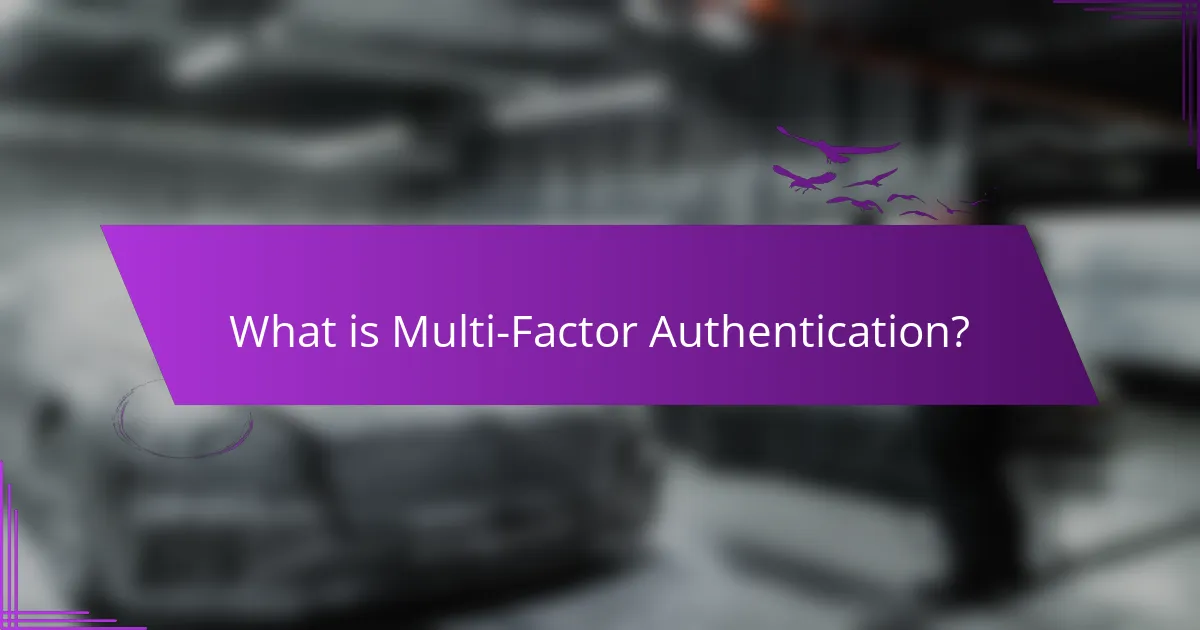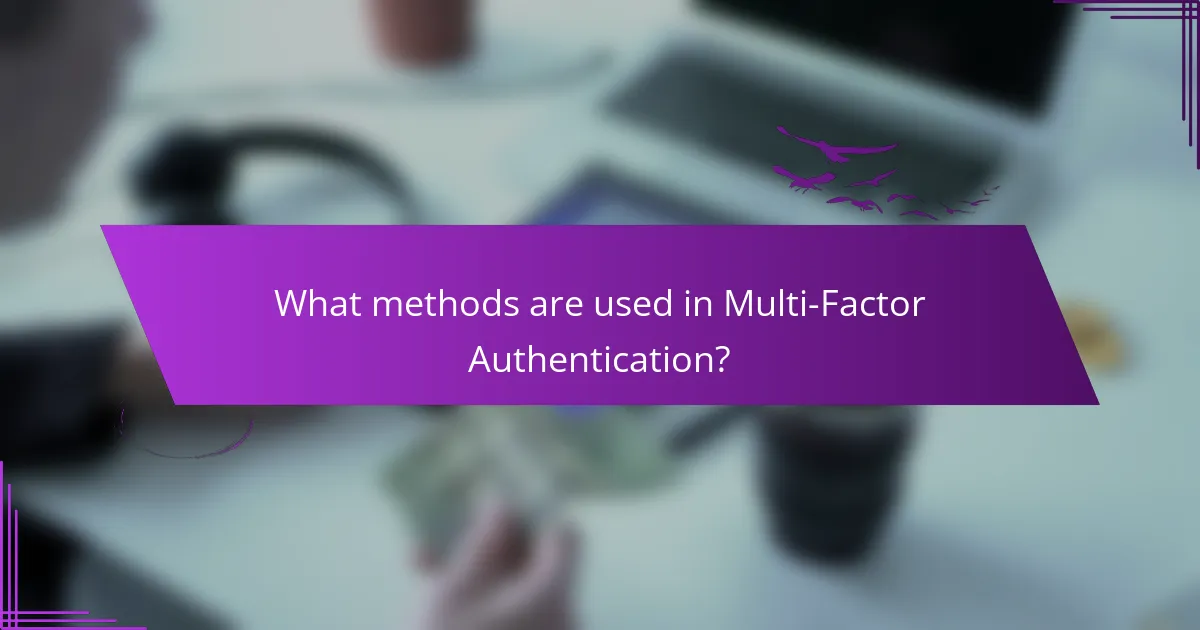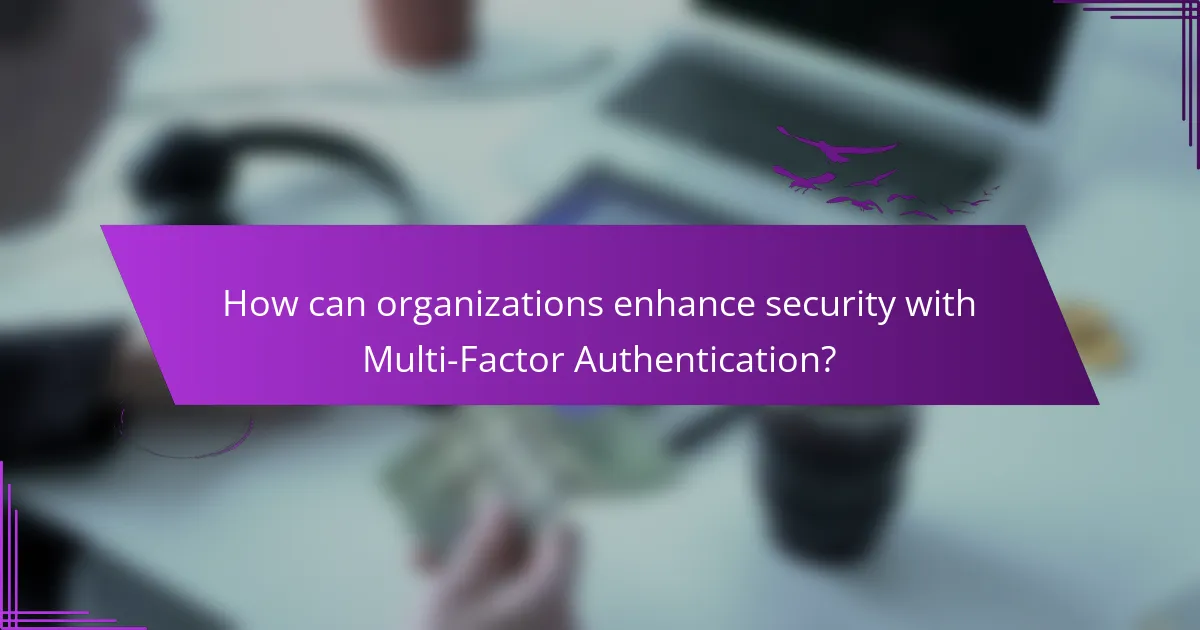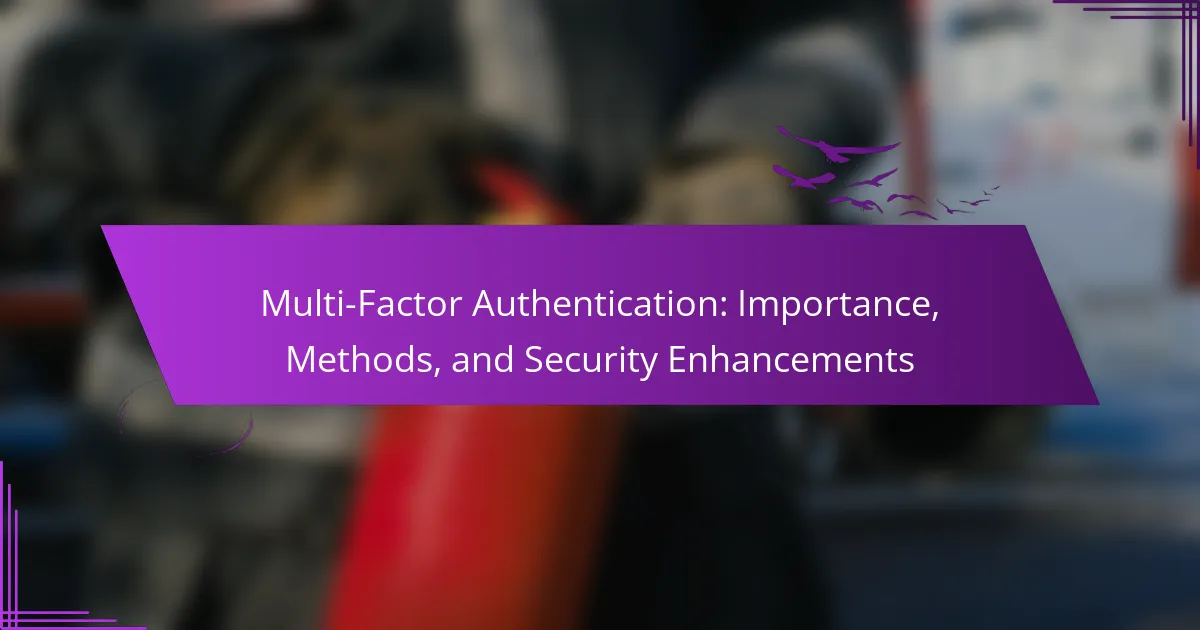
What is Multi-Factor Authentication?
Multi-Factor Authentication (MFA) is a security process that requires multiple forms of verification to access an account or system. Typically, it combines something the user knows, like a password, with something the user has, such as a smartphone for receiving a verification code. This method significantly enhances security by making unauthorized access more difficult. According to the 2020 Verizon Data Breach Investigations Report, 80% of data breaches involve weak or stolen passwords. MFA mitigates this risk by adding additional layers of security, thus protecting sensitive information more effectively.
How does Multi-Factor Authentication enhance security?
Multi-Factor Authentication (MFA) enhances security by requiring multiple forms of verification before granting access. This process significantly reduces the risk of unauthorized access. MFA typically combines something the user knows, like a password, with something the user has, like a mobile device. This layered approach makes it harder for attackers to gain access, even if they have stolen a password. According to a study by the Cybersecurity & Infrastructure Security Agency, MFA can block up to 99.9% of automated attacks. By using MFA, organizations can better protect sensitive data and systems.
What are the key components of Multi-Factor Authentication?
The key components of Multi-Factor Authentication (MFA) are something you must understand for enhanced security. MFA requires two or more verification factors to gain access to a resource. The first component is something you know, such as a password or PIN. The second component is something you have, like a smartphone or security token. The third component is something you are, which includes biometrics like fingerprints or [censured] recognition. These components work together to provide a layered security approach. According to the National Institute of Standards and Technology (NIST), MFA significantly decreases the risk of unauthorized access. Implementing MFA can reduce the chances of a security breach by up to 99.9%.
How do these components work together to protect users?
Multi-Factor Authentication (MFA) components work together by requiring multiple forms of verification to access accounts. These components typically include something the user knows (like a password), something the user has (like a smartphone), and something the user is (like a fingerprint). This layered approach enhances security by making it more difficult for unauthorized users to gain access.
For instance, even if a password is compromised, an attacker would still need the second factor, such as a one-time code sent to the user’s phone. According to a study by Google, MFA can block 100% of automated bots and 96% of phishing attacks. By combining these elements, MFA significantly reduces the risk of unauthorized access and protects sensitive information.
Why is Multi-Factor Authentication important?
Multi-Factor Authentication (MFA) is important because it enhances security by requiring multiple forms of verification. This process significantly reduces the risk of unauthorized access to accounts. Traditional password-only systems are vulnerable to attacks, such as phishing and credential theft. MFA adds an additional layer of protection, often involving something the user knows, something the user has, or something the user is. According to the Cybersecurity & Infrastructure Security Agency, MFA can block over 99% of automated cyber attacks. Implementing MFA is a proven strategy to safeguard sensitive information and maintain user trust.
What risks does Multi-Factor Authentication mitigate?
Multi-Factor Authentication (MFA) mitigates several risks associated with unauthorized access. It significantly reduces the risk of credential theft. MFA requires multiple forms of verification, making it harder for attackers to gain access. Phishing attacks are less effective against accounts protected by MFA. Even if a password is compromised, the additional authentication factors prevent unauthorized entry. MFA also mitigates risks from brute-force attacks. Attackers face increased difficulty in guessing multiple authentication factors. According to a study by Microsoft, MFA can block over 99.9% of account compromise attacks. This highlights the effectiveness of MFA in enhancing security.
How does Multi-Factor Authentication compare to single-factor authentication?
Multi-Factor Authentication (MFA) is more secure than single-factor authentication (SFA). MFA requires two or more verification methods to access an account. SFA only needs one method, typically a password. This makes SFA more vulnerable to attacks like phishing. According to a 2021 report by the Cybersecurity & Infrastructure Security Agency, MFA can block 99.9% of automated attacks. In contrast, SFA relies solely on the strength of the password. Weak passwords can easily be compromised. Therefore, MFA provides a layered defense against unauthorized access.

What methods are used in Multi-Factor Authentication?
Multi-Factor Authentication (MFA) employs various methods to enhance security. Common methods include something you know, like a password, something you have, such as a smartphone or security token, and something you are, which refers to biometric data like fingerprints or [censured] recognition. Each method adds a layer of security, making unauthorized access more difficult. For instance, using a password alongside a one-time code sent to a mobile device significantly reduces the risk of account compromise. Statistics show that MFA can block over 99% of automated cyber-attacks, supporting its effectiveness in safeguarding sensitive information.
What are the common types of Multi-Factor Authentication methods?
The common types of Multi-Factor Authentication (MFA) methods include something you know, something you have, and something you are. “Something you know” typically refers to passwords or PINs. “Something you have” includes security tokens or mobile devices that generate codes. “Something you are” involves biometric verification like fingerprints or [censured] recognition. According to the Cybersecurity and Infrastructure Security Agency (CISA), using multiple factors significantly increases security by requiring more than one form of verification. This layered approach makes unauthorized access more difficult.
How does something you know contribute to Multi-Factor Authentication?
Something you know, such as a password, contributes to Multi-Factor Authentication (MFA) by serving as one of the verification factors. MFA requires multiple forms of identification to enhance security. The first factor is typically something you know, like a password. This initial verification helps confirm the user’s identity. If a password is compromised, MFA adds additional layers of security. For example, a second factor might be something you have, like a smartphone app generating a code. This combination significantly reduces the risk of unauthorized access. According to the Cybersecurity & Infrastructure Security Agency (CISA), MFA can block 99.9% of automated attacks. Thus, something you know is essential in the MFA framework for robust security.
What role do physical tokens play in Multi-Factor Authentication?
Physical tokens serve as a critical component in Multi-Factor Authentication (MFA). They provide an additional layer of security beyond just passwords. These tokens generate unique codes that must be entered alongside a user’s password. This process significantly reduces the risk of unauthorized access. For example, if a password is compromised, the physical token acts as a second barrier. According to the National Institute of Standards and Technology (NIST), using physical tokens can lower the likelihood of successful phishing attacks. Tokens are typically in the form of USB devices or smart cards. Their use is widely accepted in secure environments, such as financial institutions and corporate networks.
How can biometric factors be integrated into Multi-Factor Authentication?
Biometric factors can be integrated into Multi-Factor Authentication (MFA) by using unique physical characteristics for user verification. Common biometric methods include fingerprint scanning, [censured] recognition, and iris scanning. These methods add an additional layer of security beyond traditional passwords. Biometric data is often collected through specialized hardware or software applications. Integration requires a secure method for storing and processing biometric information. Research indicates that biometric authentication can reduce unauthorized access significantly. A study by the National Institute of Standards and Technology found that biometric systems can achieve accuracy rates exceeding 99%. Thus, incorporating biometric factors enhances the security of MFA systems.
What are the advantages of using biometric factors?
Biometric factors provide enhanced security for authentication processes. They utilize unique physical traits, such as fingerprints, [censured] recognition, or iris patterns. This uniqueness makes it difficult for unauthorized users to gain access. Biometric systems are also user-friendly and convenient. Users do not need to remember passwords or carry tokens. Furthermore, biometric data is hard to replicate or forge, increasing overall security. According to a study by the National Institute of Standards and Technology, biometric authentication can reduce identity theft significantly. This proves that biometric factors are effective in protecting sensitive information.
What challenges do biometric methods face?
Biometric methods face several challenges that impact their effectiveness and reliability. One significant challenge is the issue of accuracy. False positives and false negatives can lead to unauthorized access or denial of legitimate users. Another challenge is the potential for spoofing. Attackers can use photos, masks, or other means to trick biometric systems. Privacy concerns also arise, as users may be hesitant to share their biometric data due to fears of misuse. Additionally, environmental factors can affect the performance of biometric systems. For example, lighting conditions can impact [censured] recognition accuracy. Furthermore, the cost of implementing biometric systems can be prohibitive for some organizations. Maintenance and updates are also necessary to ensure security, which adds to the complexity. Lastly, interoperability between different biometric systems can pose integration challenges. These factors collectively hinder the widespread adoption of biometric methods in multi-factor authentication.

How can organizations enhance security with Multi-Factor Authentication?
Organizations can enhance security with Multi-Factor Authentication (MFA) by requiring multiple forms of verification before granting access. MFA typically combines something the user knows, like a password, with something the user has, such as a smartphone or security token. This layered approach significantly reduces the risk of unauthorized access. According to a 2021 report by Microsoft, MFA can block 99.9% of automated attacks. By implementing MFA, organizations ensure that even if a password is compromised, additional verification methods protect sensitive data. This strategy not only strengthens security but also builds user trust in the organization’s commitment to safeguarding their information.
What best practices should be followed for implementing Multi-Factor Authentication?
Implementing Multi-Factor Authentication (MFA) requires specific best practices to ensure effectiveness. First, organizations should choose robust authentication methods. These can include SMS, email, or authenticator apps. Next, it is crucial to educate users about MFA. Training increases awareness of phishing attacks and the importance of security.
Additionally, regular updates to authentication methods are necessary. This helps to counter evolving threats. Organizations should also enforce MFA for all users, especially those with access to sensitive data. Implementing risk-based authentication can further enhance security. This method assesses user behavior and adapts the authentication process accordingly.
Finally, regular audits of the MFA system are vital. Audits identify vulnerabilities and ensure compliance with security policies. Research shows that organizations using MFA reduce the risk of unauthorized access by up to 99.9%. This statistic underscores the importance of adhering to these best practices.
How can user education improve the effectiveness of Multi-Factor Authentication?
User education significantly enhances the effectiveness of Multi-Factor Authentication (MFA). Educated users are more likely to understand the importance of MFA in protecting their accounts. They can recognize phishing attempts that target authentication methods. Training users on the proper use of authentication apps and hardware tokens reduces misuse. Knowledgeable users can set strong, unique passwords that complement MFA. According to a study by the Ponemon Institute, organizations with user education programs experience fewer security breaches. This demonstrates that informed users are critical in maximizing MFA’s protective capabilities.
What are common pitfalls to avoid when using Multi-Factor Authentication?
Common pitfalls to avoid when using Multi-Factor Authentication (MFA) include poor implementation, user resistance, and reliance on a single factor. Poor implementation can lead to vulnerabilities, making systems easier to breach. User resistance often stems from inconvenience, causing users to bypass or disable MFA. Relying on a single factor, such as SMS, can be risky due to interception vulnerabilities. Additionally, neglecting to educate users about MFA can result in ineffective usage. Regularly updating authentication methods is crucial to address emerging threats. These pitfalls can significantly undermine the effectiveness of MFA, reducing overall security.
What future trends may impact Multi-Factor Authentication?
Emerging technologies will significantly impact Multi-Factor Authentication (MFA). Biometric authentication methods, such as [censured] recognition and fingerprint scanning, are gaining popularity. These methods provide enhanced security and user convenience. The rise of artificial intelligence (AI) will also influence MFA. AI can analyze user behavior to detect anomalies and improve security protocols. Additionally, the integration of MFA with mobile devices is expected to grow. This trend allows for seamless authentication processes. Cloud-based MFA solutions are becoming more prevalent. They offer scalability and flexibility for organizations of all sizes. Finally, regulatory changes will push organizations to adopt stronger authentication methods. Compliance with data protection laws will drive MFA implementation.
How might advancements in technology shape Multi-Factor Authentication?
Advancements in technology will enhance Multi-Factor Authentication (MFA) by improving security and user experience. Biometric authentication methods, such as [censured] recognition and fingerprint scanning, are becoming more sophisticated. These methods increase security by utilizing unique physical attributes. Artificial intelligence can analyze user behavior patterns to detect anomalies. This helps in identifying unauthorized access attempts. Cloud-based solutions will streamline MFA processes, making them more accessible. Integration with mobile devices will facilitate seamless authentication experiences. Furthermore, advancements in cryptography will strengthen data protection in MFA systems. Overall, technology will make MFA more efficient, secure, and user-friendly.
What role will regulatory changes play in the evolution of Multi-Factor Authentication?
Regulatory changes will significantly influence the evolution of Multi-Factor Authentication (MFA). These changes often mandate stronger security measures to protect sensitive information. For instance, regulations like the General Data Protection Regulation (GDPR) and the Payment Card Industry Data Security Standard (PCI DSS) require organizations to implement MFA for enhanced user verification. Compliance with such regulations drives organizations to adopt MFA solutions. As a result, MFA becomes a standard practice across various industries. This trend is evident in sectors like finance and healthcare, where regulatory scrutiny is high. Moreover, evolving regulations will likely continue to push for more robust authentication methods. Consequently, organizations must stay ahead of compliance requirements to mitigate risks and protect user data effectively.
What practical tips can help users effectively utilize Multi-Factor Authentication?
Use strong and unique passwords alongside Multi-Factor Authentication (MFA) for enhanced security. Enable MFA on all accounts that support it. Utilize authentication apps like Google Authenticator or Authy for generating codes. Avoid SMS-based codes when possible, as they can be intercepted. Regularly update your authentication methods to stay secure. Backup your recovery codes in a safe location to prevent account lockout. Educate yourself on phishing attacks to avoid falling victim. Review account activity regularly to spot suspicious actions.
Multi-Factor Authentication (MFA) is a security process that requires multiple forms of verification to access accounts or systems, significantly reducing the risk of unauthorized access. The article covers the key components of MFA, including the verification factors of something you know, something you have, and something you are, along with their effectiveness in enhancing security against various cyber threats. It discusses the importance of MFA, the risks it mitigates, and compares it to single-factor authentication. Additionally, the article outlines best practices for implementing MFA, user education’s role, common pitfalls, and future trends impacting MFA technology and regulatory changes.
